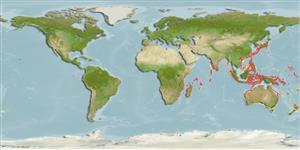>
Callionymiformes (Dragonets) >
Callionymidae (Dragonets)
Etymology: Bathycallionymus: Greek, bathys = deep + Greek, kalos, kallos = beauty + Greek, onyma, -atos = name (Ref. 45335).
More on author: Günther.
Environment: milieu / climate zone / depth range / distribution range
Ecología
marino demersal; rango de profundidad 180 - 290 m (Ref. 75992). Temperate
Indo-West Pacific: Zanzibar (Ref. 26165) to southern Japan, East China Sea, and the Banda Sea (Ref. 559).
Tamaño / Peso / Age
Maturity: Lm ? range ? - ? cm
Max length : 16.0 cm SL macho / no sexado; (Ref. 559)
Short description
Claves de identificación | Morfología | Morfometría
Espinas dorsales (total) : 4; Radios blandos dorsales (total) : 9 - 10; Espinas anales: 0; Radios blandos anales: 9. First dorsal fin elongate and filamentous. Tip of the anterior branch of last dorsal ray branched. Third membrane of the 1st dorsal fin with lunate blotch. Anal fin pale in male, faintly dusky at lower margin in the female.
Found on the shelf edge (Ref. 11230).
Life cycle and mating behavior
Maturities | Reproducción | Spawnings | Egg(s) | Fecundities | Larva
Masuda, H., K. Amaoka, C. Araga, T. Uyeno and T. Yoshino, 1984. The fishes of the Japanese Archipelago. Vol. 1. Tokai University Press, Tokyo, Japan. 437 p. (text). (Ref. 559)
IUCN Red List Status (Ref. 130435)
Threat to humans
Harmless
Human uses
Herramientas
Special reports
Download XML
Fuentes de Internet
Estimates based on models
Preferred temperature (Ref.
123201): 12.1 - 23, mean 15.2 °C (based on 93 cells).
Phylogenetic diversity index (Ref.
82804): PD
50 = 1.0000 [Uniqueness, from 0.5 = low to 2.0 = high].
Bayesian length-weight: a=0.00794 (0.00359 - 0.01758), b=2.80 (2.61 - 2.99), in cm total length, based on LWR estimates for this (Sub)family-body shape (Ref.
93245).
Nivel trófico (Ref.
69278): 3.3 ±0.4 se; based on size and trophs of closest relatives
Resiliencia (Ref.
120179): Medio, población duplicada en un tiempo mínimo de 1.4-4.4 años (Preliminary K or Fecundity.).
Fishing Vulnerability (Ref.
59153): Low vulnerability (10 of 100).
